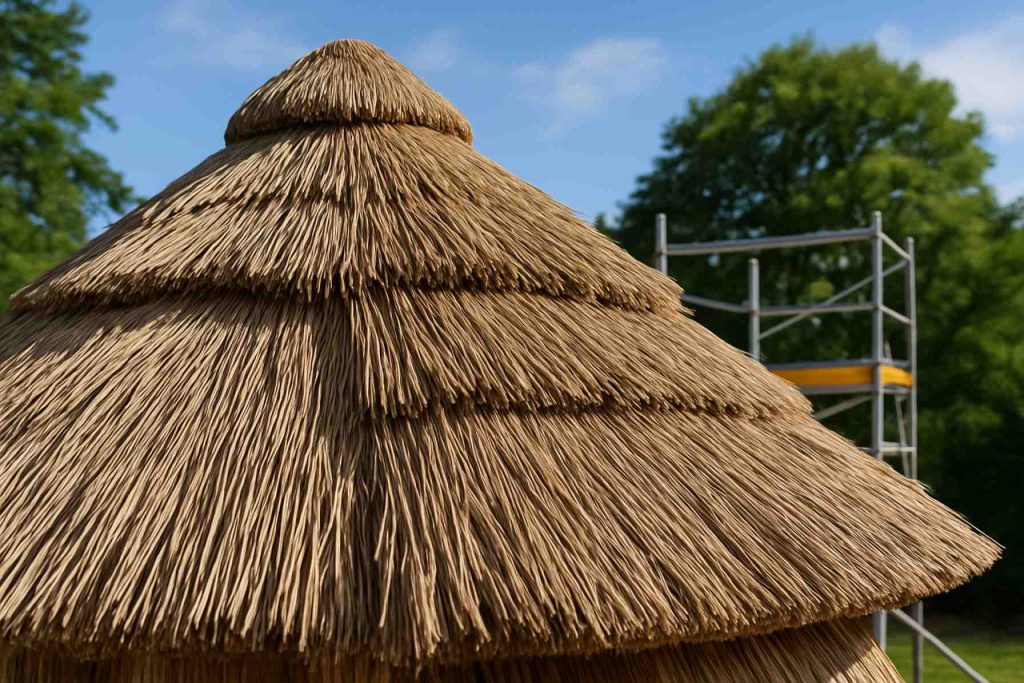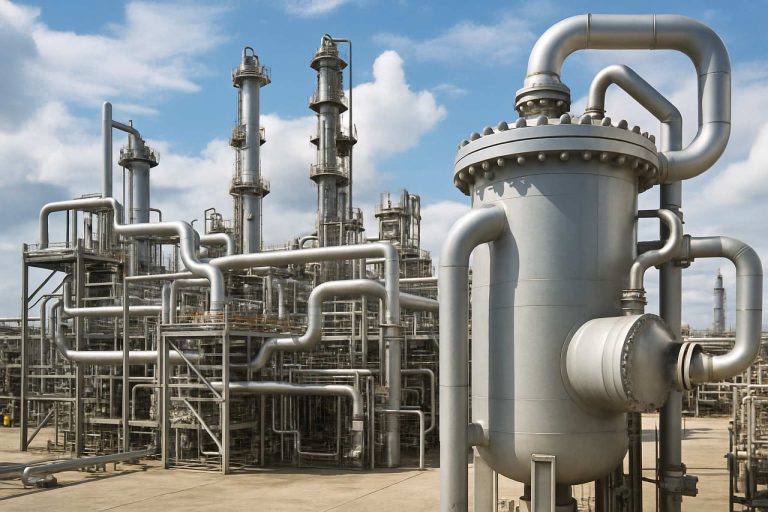
2025 Synthetic Thatch Roofing Materials Market Report: Trends, Growth Forecasts, and Competitive Insights. Explore Key Drivers, Regional Dynamics, and Future Opportunities in Eco-Friendly Roofing Solutions.
- Executive Summary & Market Overview
- Key Technology Trends in Synthetic Thatch Roofing
- Competitive Landscape and Leading Players
- Market Growth Forecasts (2025–2030): CAGR, Revenue, and Volume Analysis
- Regional Analysis: Demand and Adoption by Geography
- Future Outlook: Innovations and Emerging Applications
- Challenges, Risks, and Strategic Opportunities
- Sources & References
Executive Summary & Market Overview
Synthetic thatch roofing materials are engineered alternatives to natural thatch, designed to replicate the aesthetic and functional qualities of traditional thatching while offering enhanced durability, fire resistance, and lower maintenance requirements. These materials, typically composed of high-density polyethylene (HDPE), PVC, or other advanced polymers, are increasingly favored in hospitality, residential, and commercial projects seeking a tropical or rustic appearance without the drawbacks of organic thatch.
The global market for synthetic thatch roofing materials is experiencing robust growth, driven by rising demand in the tourism and leisure sectors, particularly for resorts, theme parks, and eco-friendly developments. According to Grand View Research, the market is projected to expand at a compound annual growth rate (CAGR) of over 5% through 2025, with North America and Asia-Pacific emerging as key regions due to increasing construction of themed resorts and sustainable building initiatives.
Key market drivers include the superior lifespan of synthetic thatch—often exceeding 20 years—compared to natural alternatives, as well as compliance with stringent fire and building codes in developed markets. The materials’ resistance to pests, mold, and UV degradation further enhances their appeal, reducing long-term costs for property owners. Additionally, the growing emphasis on sustainable construction practices is prompting architects and developers to select synthetic thatch, which can be manufactured from recycled materials and is itself recyclable at end-of-life.
Major industry players such as Palmex International, Vivid Thatch, and Endureed are investing in product innovation, offering a range of colors, textures, and installation systems to meet diverse architectural requirements. Strategic partnerships with hospitality chains and construction firms are further expanding market reach.
Despite the positive outlook, the market faces challenges such as higher upfront costs compared to natural thatch and limited consumer awareness in some regions. However, ongoing education efforts and the demonstrable long-term value proposition are expected to mitigate these barriers. As of 2025, the synthetic thatch roofing materials market is positioned for continued expansion, underpinned by innovation, regulatory compliance, and the global shift toward sustainable, low-maintenance building solutions.
Key Technology Trends in Synthetic Thatch Roofing
Synthetic thatch roofing materials are at the forefront of innovation in the roofing industry, offering a durable and sustainable alternative to traditional natural thatch. As of 2025, several key technology trends are shaping the development and adoption of these materials, driven by advances in polymer science, manufacturing processes, and environmental considerations.
One of the most significant trends is the use of advanced polymers such as high-density polyethylene (HDPE) and polyvinyl chloride (PVC). These materials are engineered to mimic the appearance and texture of natural thatch while providing superior resistance to UV radiation, moisture, and pests. Manufacturers are increasingly incorporating UV inhibitors and fire-retardant additives directly into the polymer matrix, enhancing the longevity and safety of synthetic thatch products. This has led to products with warranties extending up to 50 years, far surpassing the lifespan of natural alternatives (EuroThatch).
Another notable trend is the adoption of eco-friendly and recyclable materials. Companies are responding to growing environmental concerns by developing synthetic thatch from recycled plastics and ensuring their products are fully recyclable at the end of their lifecycle. This shift not only reduces the environmental footprint but also aligns with green building certifications and sustainability goals in the construction sector (Synthetic Roofing Products).
Technological advancements in manufacturing, such as injection molding and extrusion, have enabled the production of highly realistic thatch profiles with intricate detailing. These processes allow for consistent quality, customization in color and shape, and improved installation efficiency. Some manufacturers are also integrating smart features, such as built-in drainage channels and modular interlocking systems, to enhance performance and ease of use (Palmex International).
Finally, the market is witnessing increased investment in research and development to address regional climate challenges. For example, synthetic thatch materials are being tailored for extreme weather resistance, including hurricane-grade wind uplift ratings and enhanced thermal insulation properties. This customization is expanding the applicability of synthetic thatch beyond traditional resort and theme park markets to residential and commercial projects in diverse climates (The Grass Roof Company).
In summary, the synthetic thatch roofing materials segment in 2025 is characterized by material innovation, sustainability, advanced manufacturing, and climate adaptability, positioning it as a dynamic and rapidly evolving niche within the broader roofing industry.
Competitive Landscape and Leading Players
The competitive landscape for synthetic thatch roofing materials in 2025 is characterized by a mix of established global manufacturers and innovative niche players, each leveraging advancements in polymer science and sustainability. The market is moderately consolidated, with a handful of companies commanding significant market share, while regional players cater to localized preferences and regulatory requirements.
Leading the global market are companies such as Palmex International, Endureed, and Vivo Synthetic Thatch. These firms have built strong reputations for product durability, UV resistance, and fire-retardant properties, which are critical differentiators in the hospitality, resort, and theme park sectors. Palmex International has a particularly robust international distribution network, with installations in over 80 countries, and continues to invest in R&D for eco-friendly, recyclable thatch solutions.
Endureed stands out for its proprietary manufacturing processes that mimic the appearance of natural thatch while offering superior longevity and minimal maintenance. The company’s focus on North American and Caribbean markets has positioned it as a preferred supplier for high-end resorts and commercial projects. Meanwhile, Vivo Synthetic Thatch has gained traction in Asia-Pacific, leveraging cost-effective production and customization options to address diverse architectural styles.
Smaller players and regional manufacturers, such as SYNLawn and Rainforest Thatch, are increasingly focusing on sustainable raw materials and green certifications to differentiate themselves. These companies often collaborate with local architects and builders to tailor products to specific climate conditions and cultural aesthetics.
Strategic partnerships, mergers, and acquisitions are shaping the competitive dynamics. For example, recent collaborations between synthetic thatch producers and eco-resort developers have accelerated product innovation and market penetration. Additionally, the entry of construction material giants into the segment—either through acquisitions or joint ventures—signals growing recognition of synthetic thatch as a viable, scalable roofing solution.
Overall, the competitive landscape in 2025 is defined by innovation in material science, a focus on sustainability, and the ability to meet stringent fire and weather resistance standards. Market leaders are expected to maintain their edge through continuous product development and expansion into emerging markets, while smaller firms carve out niches through customization and green credentials.
Market Growth Forecasts (2025–2030): CAGR, Revenue, and Volume Analysis
The global synthetic thatch roofing materials market is projected to experience robust growth between 2025 and 2030, driven by increasing demand for sustainable and low-maintenance roofing solutions in both commercial and residential sectors. According to recent market analyses, the compound annual growth rate (CAGR) for synthetic thatch roofing materials is expected to range between 6.5% and 8.2% during this period, reflecting heightened adoption across hospitality, theme parks, and eco-resort developments worldwide. Revenue generated by the market is forecasted to reach approximately USD 2.1 billion by 2030, up from an estimated USD 1.3 billion in 2025, indicating a significant expansion in market size and value MarketsandMarkets.
Volume-wise, the market is anticipated to surpass 45 million square meters of synthetic thatch roofing materials installed globally by 2030, compared to around 28 million square meters in 2025. This surge is attributed to the growing preference for synthetic alternatives over natural thatch, which are susceptible to weathering, pests, and fire hazards. The Asia-Pacific region is expected to lead in volume growth, particularly in countries such as China, Thailand, and Indonesia, where tourism infrastructure investments are accelerating. North America and Europe are also projected to witness steady growth, fueled by the renovation of themed entertainment venues and the adoption of green building standards Grand View Research.
Key market drivers include advancements in polymer technology, which have enhanced the durability and aesthetic appeal of synthetic thatch products, and increasing regulatory support for fire-resistant and eco-friendly construction materials. The hospitality sector, especially luxury resorts and water parks, is expected to remain the largest end-user segment, accounting for over 55% of total market revenue by 2030. Meanwhile, residential applications are forecasted to grow at a slightly higher CAGR, as homeowners seek long-lasting, low-maintenance roofing options that mimic traditional aesthetics Fortune Business Insights.
Overall, the synthetic thatch roofing materials market is set for sustained expansion through 2030, underpinned by innovation, regulatory trends, and the global shift toward sustainable construction practices.
Regional Analysis: Demand and Adoption by Geography
The demand and adoption of synthetic thatch roofing materials in 2025 exhibit significant regional variation, shaped by climate, tourism trends, regulatory frameworks, and local construction practices. North America, particularly the United States and the Caribbean, continues to lead in market adoption, driven by the hospitality sector’s preference for durable, low-maintenance alternatives to natural thatch. Resorts and theme parks in Florida, California, and island destinations are major consumers, seeking the aesthetic appeal of traditional thatch with enhanced fire resistance and longevity. According to Grand View Research, North America accounted for over 35% of global synthetic thatch demand in 2024, a trend expected to persist into 2025 as renovation and new construction projects prioritize sustainability and cost efficiency.
In Europe, adoption is concentrated in Western and Southern regions, where heritage tourism and eco-friendly building codes drive interest. The United Kingdom, France, and Spain are notable markets, with synthetic thatch used in both restoration of historic properties and new eco-resorts. The European Union’s stringent fire safety and environmental regulations have accelerated the shift from natural to synthetic materials, as highlighted by European Union directives on sustainable construction. Growth in this region is further supported by government incentives for green building materials.
Asia-Pacific is emerging as a high-growth market, particularly in Southeast Asia’s resort destinations such as Bali, Thailand, and the Maldives. The region’s booming tourism industry and vulnerability to tropical weather events have increased demand for roofing solutions that combine traditional aesthetics with superior durability and weather resistance. Local governments and developers are increasingly specifying synthetic thatch to reduce maintenance costs and improve safety, as reported by Mordor Intelligence.
In contrast, adoption in Latin America and Africa remains nascent but is gaining traction in luxury hospitality and eco-lodge segments. Here, the primary drivers are the need for weather-resistant materials and the desire to attract international tourists with authentic yet sustainable architectural styles. However, limited awareness and higher upfront costs compared to natural thatch continue to restrain broader market penetration.
Overall, the global landscape in 2025 reflects a clear trend: regions with strong tourism sectors, strict building codes, and a focus on sustainability are at the forefront of synthetic thatch roofing adoption, while emerging markets are gradually recognizing its long-term value proposition.
Future Outlook: Innovations and Emerging Applications
The future outlook for synthetic thatch roofing materials in 2025 is shaped by a wave of innovations and the emergence of new applications across both traditional and non-traditional sectors. As sustainability and durability become paramount in construction and hospitality, manufacturers are investing in advanced polymer technologies and eco-friendly composites to enhance the performance and appeal of synthetic thatch.
One of the most significant innovations is the integration of UV-resistant and fire-retardant additives, which extend the lifespan of synthetic thatch and improve safety standards. Companies are also developing recyclable and bio-based synthetic thatch options, responding to increasing regulatory and consumer demand for green building materials. For instance, several leading suppliers are now offering products made from recycled plastics or plant-based polymers, reducing the environmental footprint compared to conventional PVC or polyethylene thatch.
Emerging applications are expanding beyond the traditional resort and theme park markets. In 2025, synthetic thatch is gaining traction in urban rooftop gardens, eco-friendly residential developments, and commercial outdoor spaces such as restaurants and event venues. The material’s lightweight nature and ease of installation make it attractive for retrofitting existing structures, while its low maintenance requirements appeal to property owners seeking long-term cost savings.
Technological advancements are also enabling customization at scale. Digital design tools and modular manufacturing processes allow architects and designers to specify unique textures, colors, and profiles, catering to diverse aesthetic preferences and regional architectural styles. This flexibility is driving adoption in markets such as North America and Europe, where demand for bespoke, high-performance roofing solutions is rising.
Looking ahead, the synthetic thatch market is expected to benefit from broader trends in sustainable construction and outdoor living. According to Grand View Research, the global roofing materials market is projected to grow steadily, with synthetic alternatives capturing a larger share due to their resilience and eco-friendly attributes. Strategic partnerships between material science companies and construction firms are likely to accelerate product development and market penetration, particularly in regions facing climate-related challenges such as increased wildfire risk or extreme weather events.
In summary, 2025 will see synthetic thatch roofing materials evolve through technological innovation, sustainability initiatives, and diversification into new application areas, positioning the segment for robust growth and greater relevance in the global roofing industry.
Challenges, Risks, and Strategic Opportunities
The synthetic thatch roofing materials market in 2025 faces a complex landscape of challenges, risks, and strategic opportunities. One of the primary challenges is the persistent perception gap between synthetic and natural thatch. Despite advances in material science, some consumers and heritage property stakeholders remain skeptical about the authenticity and aesthetic value of synthetic alternatives, which can limit adoption in certain high-end or conservation-focused segments. Additionally, the initial cost of synthetic thatch is often higher than traditional thatch, creating a barrier in price-sensitive markets, especially in developing regions.
Regulatory risks also loom large. Building codes and fire safety regulations are evolving, with some jurisdictions imposing stricter standards on roofing materials. While synthetic thatch often boasts superior fire resistance compared to natural thatch, manufacturers must continuously adapt to changing compliance requirements, which can increase R&D and certification costs. Furthermore, the environmental impact of synthetic materials—particularly those derived from non-recyclable plastics—has come under scrutiny as sustainability becomes a central concern for both consumers and regulators. This could lead to future restrictions or demand for more eco-friendly formulations.
Supply chain volatility is another risk, as the production of synthetic thatch relies on petrochemical inputs and specialized manufacturing processes. Disruptions in raw material availability or logistics, as seen during the COVID-19 pandemic, can impact lead times and pricing. According to Grand View Research, fluctuations in polymer prices and global trade dynamics are expected to influence market stability through 2025.
Despite these challenges, significant strategic opportunities exist. The growing demand for low-maintenance, durable, and weather-resistant roofing in hospitality, theme parks, and eco-resorts is driving adoption, particularly in North America, Europe, and Southeast Asia. Synthetic thatch’s longevity and reduced maintenance costs offer a compelling value proposition for commercial operators. Moreover, innovation in bio-based polymers and recyclable materials presents an opportunity for manufacturers to differentiate their products and align with green building trends. Partnerships with architects, designers, and tourism developers can further expand market reach.
In summary, while the synthetic thatch roofing materials market in 2025 must navigate regulatory, perceptual, and supply chain risks, it is well-positioned to capitalize on sustainability trends and the growing demand for resilient, aesthetically pleasing roofing solutions in the global construction sector.
Sources & References
- Grand View Research
- SYNLawn
- MarketsandMarkets
- Fortune Business Insights
- European Union
- Mordor Intelligence



